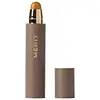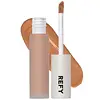Merit Beauty The Minimalist Perfecting Complexion Foundation and Concealer Stick Versus REFY Serum Concealer
What's inside
What's inside
 Key Ingredients
Key Ingredients

 Benefits
Benefits

 Concerns
Concerns

No concerns
 Ingredients Side-by-side
Ingredients Side-by-side

Hydrogenated Polydecene
EmollientCaprylic/Capric Triglyceride
MaskingOctyldodecanol
EmollientSilica
AbrasivePolyethylene
AbrasiveDipentaerythrityl Hexahydroxystearate/Hexastearate/Hexarosinate
Skin ConditioningHydrogenated Polyisobutene
EmollientCopernicia Cerifera Wax
Synthetic Wax
AbrasiveTriethoxycaprylylsilane
Cera Microcristallina
Emulsion StabilisingSorbitan Isostearate
EmulsifyingPancratium Maritimum Extract
BleachingTocopheryl Acetate
AntioxidantDimethicone
EmollientCaprylyl Glycol
EmollientPropylene Carbonate
SolventEthylhexylglycerin
Skin Conditioning1,2-Hexanediol
Skin ConditioningStearalkonium Hectorite
Gel FormingGlycerin
HumectantWater
Skin ConditioningMica
Cosmetic ColorantBHT
AntioxidantCI 77491
Cosmetic ColorantCI 77891
Cosmetic ColorantHydrogenated Polydecene, Caprylic/Capric Triglyceride, Octyldodecanol, Silica, Polyethylene, Dipentaerythrityl Hexahydroxystearate/Hexastearate/Hexarosinate, Hydrogenated Polyisobutene, Copernicia Cerifera Wax, Synthetic Wax, Triethoxycaprylylsilane, Cera Microcristallina, Sorbitan Isostearate, Pancratium Maritimum Extract, Tocopheryl Acetate, Dimethicone, Caprylyl Glycol, Propylene Carbonate, Ethylhexylglycerin, 1,2-Hexanediol, Stearalkonium Hectorite, Glycerin, Water, Mica, BHT, CI 77491, CI 77891
Water
Skin ConditioningCoco-Caprylate/Caprate
EmollientPropanediol
SolventCellulose
AbsorbentSqualane
EmollientHydrogenated Didecene
Skin ConditioningGlycerin
HumectantMethylpropanediol
SolventDisteardimonium Hectorite
StabilisingPolyglyceryl-4 Isostearate
EmulsifyingPolyglyceryl-3 Polyricinoleate
EmulsifyingSorbitan Isostearate
EmulsifyingShorea Robusta Resin
TonicHelianthus Annuus Seed Wax
Skin ConditioningHelianthus Annuus Seed Oil
EmollientPropylene Carbonate
SolventCaprylyl Glycol
EmollientAluminum Hydroxide
EmollientPotassium Sorbate
PreservativeSodium Dehydroacetate
PreservativeEvodia Rutaecarpa Fruit Extract
Skin ConditioningSodium Lauroyl Glutamate
Phenylpropanol
MaskingLysine
Skin ConditioningMagnesium Chloride
Tocopherol
AntioxidantCaprylic/Capric Triglyceride
MaskingCamellia Sinensis Leaf Extract
AntimicrobialAlaria Esculenta Extract
Skin ProtectingCI 77163
Cosmetic ColorantIron Oxides
CI 77891
Cosmetic ColorantWater, Coco-Caprylate/Caprate, Propanediol, Cellulose, Squalane, Hydrogenated Didecene, Glycerin, Methylpropanediol, Disteardimonium Hectorite, Polyglyceryl-4 Isostearate, Polyglyceryl-3 Polyricinoleate, Sorbitan Isostearate, Shorea Robusta Resin, Helianthus Annuus Seed Wax, Helianthus Annuus Seed Oil, Propylene Carbonate, Caprylyl Glycol, Aluminum Hydroxide, Potassium Sorbate, Sodium Dehydroacetate, Evodia Rutaecarpa Fruit Extract, Sodium Lauroyl Glutamate, Phenylpropanol, Lysine, Magnesium Chloride, Tocopherol, Caprylic/Capric Triglyceride, Camellia Sinensis Leaf Extract, Alaria Esculenta Extract, CI 77163, Iron Oxides, CI 77891
 Reviews
Reviews

Ingredients Explained
These ingredients are found in both products.
Ingredients higher up in an ingredient list are typically present in a larger amount.
This ingredient is an emollient, solvent, and texture enhancer. It is considered a skin-softener by helping the skin prevent moisture loss.
It helps thicken a product's formula and makes it easier to spread by dissolving clumping compounds.
Caprylic Triglyceride is made by combining glycerin with coconut oil, forming a clear liquid.
While there is an assumption Caprylic Triglyceride can clog pores due to it being derived from coconut oil, there is no research supporting this.
Learn more about Caprylic/Capric TriglycerideCaprylyl Glycol is a humectant and emollient, meaning it attracts and preserves moisture.
It is a common ingredient in many products, especially those designed to hydrate skin. The primary benefits are retaining moisture, skin softening, and promoting a healthy skin barrier.
Though Caprylyl Glycol is an alcohol derived from fatty acids, it is not the kind that can dry out skin.
This ingredient is also used as a preservative to extend the life of products. It has slight antimicrobial properties.
Learn more about Caprylyl GlycolCi 77891 is a white pigment from Titanium dioxide. It is naturally found in minerals such as rutile and ilmenite.
It's main function is to add a white color to cosmetics. It can also be mixed with other colors to create different shades.
Ci 77891 is commonly found in sunscreens due to its ability to block UV rays.
Learn more about CI 77891Glycerin is already naturally found in your skin. It helps moisturize and protect your skin.
A study from 2016 found glycerin to be more effective as a humectant than AHAs and hyaluronic acid.
As a humectant, it helps the skin stay hydrated by pulling moisture to your skin. The low molecular weight of glycerin allows it to pull moisture into the deeper layers of your skin.
Hydrated skin improves your skin barrier; Your skin barrier helps protect against irritants and bacteria.
Glycerin has also been found to have antimicrobial and antiviral properties. Due to these properties, glycerin is often used in wound and burn treatments.
In cosmetics, glycerin is usually derived from plants such as soybean or palm. However, it can also be sourced from animals, such as tallow or animal fat.
This ingredient is organic, colorless, odorless, and non-toxic.
Glycerin is the name for this ingredient in American English. British English uses Glycerol/Glycerine.
Learn more about GlycerinThis ingredient is a solvent. It helps dissolve active ingredients and alter the texture of products.
Propylene Carbonate is commonly used in makeup and with clay, such as montmorillonite or bentonite.
Studies show this ingredient to be safe for cosmetics. When it is undiluted, it can cause skin irritation. (It is always diluted in skincare and makeup). This ingredient is water-soluble.
Propylene Carbonate is created from propylene glycol and carbonic acid.
Learn more about Propylene CarbonateSorbitan Isostearate is an emulsifer and cleaning agent. It is created from isostearic acid and sorbitol.
As an emulsifier, Sorbitan Isostearate prevents oils and water from separating.
Due to its isostearic acid base, it may not be safe for Malassezia or fungal acne.
Learn more about Sorbitan IsostearateWater. It's the most common cosmetic ingredient of all. You'll usually see it at the top of ingredient lists, meaning that it makes up the largest part of the product.
So why is it so popular? Water most often acts as a solvent - this means that it helps dissolve other ingredients into the formulation.
You'll also recognize water as that liquid we all need to stay alive. If you see this, drink a glass of water. Stay hydrated!
Learn more about Water